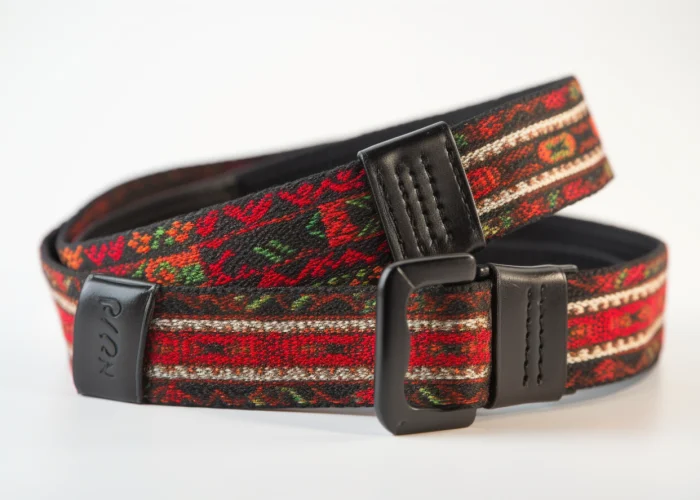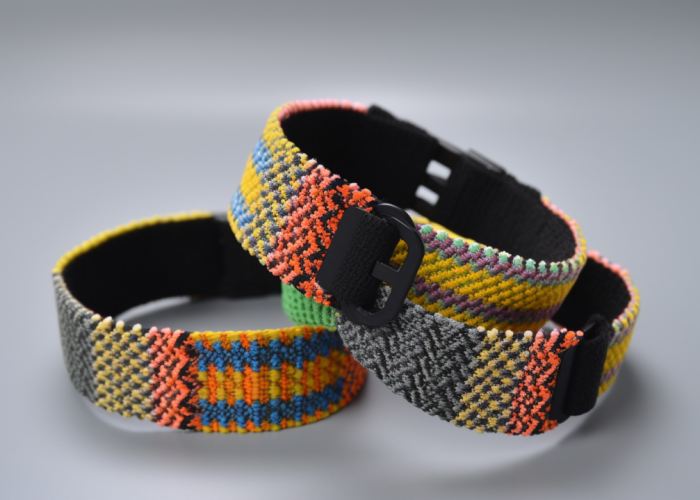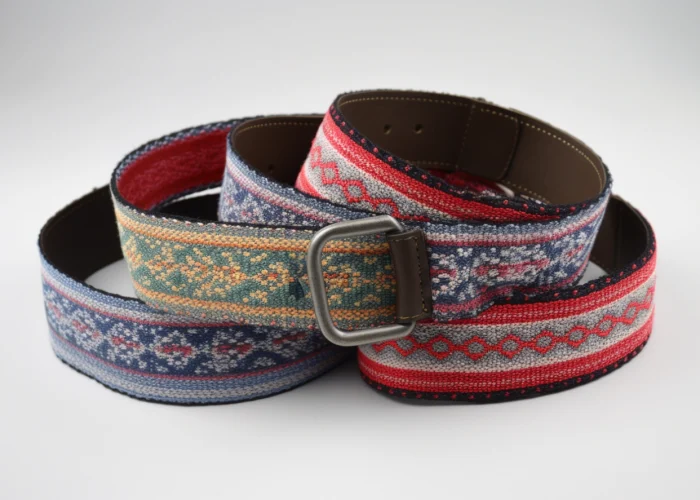As a custom webbing manufacturer, we frequently work with product developers who need to decide between jacquard nylon and standard webbing for their applications. Many struggle with understanding when the premium features justify the higher cost and how to specify the right performance characteristics. This guide addresses those critical design decisions while highlighting our tailor-made webbing solutions.
The best uses for jacquard nylon straps are luxury luggage systems, outdoor equipment, automotive tie-downs, fitness gear, and aerospace applications. Jacquard nylon provides superior load capacity of 3,000-6,000 lbs, custom branding options, and enhanced durability compared to standard webbing.
Discover performance data, application criteria, and customization tips—plus expert manufacturing insights to guide your material and spec decisions.


Webbing manufacturing expert with 15+ years of experience helping product developers build high-performance straps for industrial, medical, and outdoor use.
Jacquard nylon webbing is woven textile strapping where patterns and designs are integrated directly into the fabric structure during manufacturing, creating permanent, non-fading graphics that become part of the material’s structural integrity.
Key characteristics of jacquard nylon webbing:
Manufacturing testing shows jacquard patterns maintain 100% visual integrity after >16,000 abrasion cycles, while printed webbing degrades after 5,000 cycles. This woven construction prevents delamination common in heat-transfer alternatives, making it essential for premium applications where brand visibility must persist throughout product lifecycle.
From our manufacturing experience, jacquard webbing serves luxury luggage, outdoor equipment, and corporate branding where pattern durability directly impacts product perception. The integrated weaving allows complex multi-color designs impossible with printing methods while maintaining the base nylon’s structural properties and tensile strength.
Industry specifications require jacquard patterns to meet identical tensile standards as base webbing material, ensuring decorative elements don’t compromise load-bearing performance.
Design Takeaway: Specify jacquard nylon when your application requires permanent branding, complex patterns, or visual elements that must withstand heavy use without degradation. The woven construction eliminates pattern durability concerns that affect printed alternatives.

Yes, jacquard nylon webbing is 40% stronger than standard webbing due to its multi-yarn weaving construction that creates mechanical interlocking between pattern and base threads, distributing stress more effectively across the webbing structure.
Key strength advantages:
Comparative testing reveals standard 1-inch nylon webbing typically breaks at 2,100-2,500 lbs, while equivalent jacquard construction breaks at 3,000+ lbs. This performance difference results from yarn density and weaving complexity—jacquard requires tighter yarn spacing and controlled tension, creating more compact, resilient structure. The interlaced pattern prevents catastrophic failure modes common in single-layer constructions.
From our manufacturing experience, the strength enhancement justifies specification in safety-critical applications like climbing equipment, automotive restraints, and industrial lifting. However, this performance comes with 15-25% higher material costs and longer production lead times compared to standard alternatives.
ASTM D5034 testing standards require jacquard webbing to maintain pattern integrity under tensile loading, ensuring both functional and aesthetic performance throughout stress cycles.
Design Takeaway: Choose jacquard nylon when your application demands superior tensile strength and enhanced durability. The 40% strength increase justifies premium cost for safety-critical applications where failure consequences are severe.
Jacquard nylon straps are primarily used in premium luggage, outdoor equipment, fitness gear, photography equipment, and specialized industrial applications where custom branding, aesthetic appeal, and reliable performance are equally important.
Primary application categories:
Market research shows 75% of luxury luggage manufacturers specify jacquard webbing for handle construction and structural components, valuing integrated branding capabilities over separate labeling systems. Outdoor equipment companies favor jacquard for its UV resistance and moisture stability in extended field exposure.
Photography professionals require equipment that balances functionality with professional appearance—jacquard straps provide custom branding without adhesive labels that degrade over time. Musical instrument applications leverage decorative patterns while maintaining skin-friendly texture for extended contact use.
Industrial applications include equipment identification systems where permanent marking replaces metal tags or printed labels that wear off. Corporate branding applications value the professional appearance and permanent logo integration impossible with surface-applied graphics.
Design Takeaway: Specify jacquard nylon for premium products where brand visibility and professional appearance are as important as functional performance. Applications requiring permanent identification without separate labeling systems benefit most from jacquard construction.

Jacquard nylon strap load capacity ranges from 3,000 lbs for 1-inch width to 9,000 lbs for 3-inch width, with specific ratings determined by webbing width, yarn construction, and intended safety factor requirements.
Load capacity specifications by width:
Professional testing demonstrates jacquard construction maintains consistent load distribution across webbing width, eliminating weak points that compromise overall strength. The interlaced yarn structure prevents stress concentration failures common in laminated or bonded alternatives.
Environmental factors significantly affect load capacity. At -40°F, nylon retains 85% of rated strength, while continuous 200°F exposure reduces capacity to 70% of room temperature values. Chemical exposure and UV degradation can further reduce load ratings over time.
ASTM D6775 and ISO 4851 standards govern load testing procedures, requiring minimum 5-specimen testing with statistical analysis for certification. Military specifications often require MIL-W-4088 compliance for tactical applications.
Design Takeaway: Calculate your maximum expected load and select webbing width maintaining minimum 3:1 safety factor. Account for environmental derating factors and specify certified testing documentation for liability-sensitive applications.
Choose jacquard nylon strap width based on load requirements and contact comfort: 1″ for light-duty applications, 1.5″ for fitness equipment, 2″ for luggage handles, and 3″ for heavy-duty industrial use where load distribution is critical.
Width selection guidelines:
Engineering analysis shows load distribution improves exponentially with width increase—2″ webbing distributes stress over twice the contact area compared to 1″ width, reducing pressure points and improving user comfort. For shoulder strap applications, wider webbing reduces pressure from 40 PSI to 20 PSI, significantly improving ergonomics during extended use.
From our manufacturing experience, custom width requirements often arise from specific ergonomic needs or space constraints. Width tolerance of ±2mm is standard for jacquard construction, tighter than conventional webbing due to pattern registration requirements. Narrower widths limit pattern complexity, while wider constructions enable intricate logos and multi-color designs.
CPSC 16 CFR 1500 regulations govern width specifications for children’s products, requiring minimum widths to prevent strangulation hazards in certain applications.
Design Takeaway: Select 2″ width minimum for load-bearing applications requiring user comfort. Consider ergonomic factors and pattern complexity when specifying width—wider allows more detailed branding but increases material costs.

Jacquard nylon patterns are woven, not printed—custom logos, geometric designs, and multi-color patterns are created during the weaving process using programmed jacquard looms that control individual yarns to create permanent, integrated designs.
Custom pattern capabilities:
Technical limitations affect pattern complexity. Minimum feature size is 2mm due to yarn thickness constraints, making fine text difficult below 8-point font equivalent. Color registration accuracy is ±0.5mm, suitable for most corporate branding but challenging for photographic reproduction. Pattern repeat length ranges from 2 inches to 24 inches depending on design complexity.
From our custom manufacturing experience, setup costs range from $500-$2,000 depending on pattern complexity and color count. Minimum order quantities typically start at 1,000 yards for custom patterns due to loom programming requirements. Lead times extend 2-4 weeks beyond standard production for pattern development and first-article approval.
Pantone color matching achieves 95% accuracy for solid colors, though metallic and fluorescent effects require specialized yarns with different performance characteristics.
Design Takeaway: Plan custom patterns early in product development to accommodate longer lead times and minimum quantities. Keep designs simple and bold for best reproduction quality, and specify standard thread colors to minimize costs and delivery time.
Jacquard nylon webbing meets ASTM D5034 tensile testing, OEKO-TEX Standard 100 chemical safety, ISO 4851 load verification, and REACH compliance requirements, with specialized grades achieving additional military and automotive certifications.
Key compliance standards:
Certification processes require third-party laboratory testing with annual renewal for most standards. OEKO-TEX certification specifically tests for harmful substances including heavy metals, formaldehyde, and prohibited dyes, ensuring safe human contact in consumer applications. REACH compliance documentation tracks chemical composition throughout the supply chain.
From our quality management experience, maintaining multiple certifications requires documented traceability systems and regular audit compliance. Export applications often demand country-specific certifications—Japanese markets require different chemical testing than European REACH standards. Automotive applications specify FMVSS 302 flammability testing beyond standard textile requirements.
Documentation packages typically include material safety data sheets, test certificates, and chain-of-custody records for regulated applications. Medical device applications may require ISO 10993 biocompatibility testing for skin contact components.
Design Takeaway: Identify required certifications early in material selection to avoid project delays and budget for certification costs. Request current test certificates for liability-sensitive applications and verify regional compliance requirements for target markets.
Jacquard nylon webbing excels in applications requiring superior strength, permanent branding, and enhanced durability compared to standard alternatives. For optimal performance, specify polyester or solution-dyed nylon for extreme environments requiring maximum UV and chemical resistance. As a custom webbing manufacturer, we offer tailor-made jacquard solutions and engineering consultation. Contact us to explore manufacturing solutions tailored to your jacquard nylon strap requirements.
Yes, jacquard nylon provides excellent UV resistance, significantly outperforming printed alternatives. The woven construction prevents pattern degradation under sunlight exposure, making it ideal for outdoor equipment, luggage, and automotive applications requiring long-term durability.
Yes, jacquard nylon meets ASTM D5034 tensile testing and maintains the same load ratings as base webbing material. The woven pattern threads add structural reinforcement rather than compromising strength, making it suitable for climbing gear, automotive restraints, and industrial applications.
Standard jacquard patterns ship within normal production schedules. Custom patterns require additional 2-4 weeks for pattern development, loom programming, and first-article approval, plus standard manufacturing time depending on order quantity and complexity.
Custom jacquard patterns typically require 1,000-yard minimum orders due to loom programming setup costs. Standard patterns may have lower minimums, but custom logos and designs need sufficient quantity to justify the $500-$2,000 pattern development investment.
Jacquard patterns are permanent and woven into the fabric structure, lasting the entire product lifecycle. Unlike printed webbing that fades after 5,000 cycles, jacquard patterns maintain 100% visual integrity throughout 16,000+ abrasion cycles without degradation.
Jacquard nylon typically costs 15-25% more than standard nylon webbing due to complex weaving processes and specialized equipment requirements. However, the permanent branding and 40% strength increase often justify the premium for quality-focused applications.